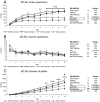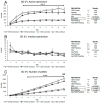Olfactory Bulbectomy Model of Depression Lowers Responding for Food in Male and Female Rats: The Modulating Role of Caloric Restriction and Response Requirement
- PMID: 37760922
- PMCID: PMC10525806
- DOI: 10.3390/biomedicines11092481
Olfactory Bulbectomy Model of Depression Lowers Responding for Food in Male and Female Rats: The Modulating Role of Caloric Restriction and Response Requirement
Abstract
Depression is a psychiatric disorder characterized by a marked decrease in reward sensitivity. By using the olfactory bulbectomy (OBX) model of depression, it was shown that OBX rats display enhanced drug-taking and seeking behaviors in a self-administration paradigm than sham-operated (SHAM) controls, and sex is an important regulating factor. To reveal potential strain effects, we compared the operant behavior of male and female Sprague-Dawley and Wistar OBX and SHAM rats trained to self-administer palatable food pellets. Results showed that Sprague-Dawley OBX rats of both sexes exhibited lower operant responding rates and food intake than SHAM controls. Food restriction increased responding in both OBX and SHAM groups. Female rats responded more than males, but the OBX lesion abolished this effect. In Wistar rats, bulbectomy lowered food self-administration only during the last training days. Food self-administration was not significantly affected in Wistar rats by sex. In summary, this study showed that bulbectomy significantly reduces operant responding and food intake in male and female Sprague-Dawley rats while inducing a mild reducing effect only in the Wistar strain. Strain-dependent effects were also observed in the modulating role of sex and food restriction on operant responding and palatable food intake.
Keywords: depression; olfactory bulbectomy; reward; self-administration; sex; strain.
Conflict of interest statement
The authors declare no conflict of interest.
Figures






Similar articles
-
Sex and Feeding Status Differently Affect Natural Reward Seeking Behavior in Olfactory Bulbectomized Rats.Front Behav Neurosci. 2018 Oct 30;12:255. doi: 10.3389/fnbeh.2018.00255. eCollection 2018. Front Behav Neurosci. 2018. PMID: 30425627 Free PMC article.
-
Olfactory bulbectomy increases reinstatement of methamphetamine seeking after a forced abstinence in rats.Behav Brain Res. 2016 Jan 15;297:20-7. doi: 10.1016/j.bbr.2015.09.035. Epub 2015 Oct 22. Behav Brain Res. 2016. PMID: 26431766
-
Enhanced self-administration of the CB1 receptor agonist WIN55,212-2 in olfactory bulbectomized rats: evaluation of possible serotonergic and dopaminergic underlying mechanisms.Front Pharmacol. 2014 Mar 20;5:44. doi: 10.3389/fphar.2014.00044. eCollection 2014. Front Pharmacol. 2014. PMID: 24688470 Free PMC article.
-
The effects of N-acetylcysteine on cocaine reward and seeking behaviors in a rat model of depression.Behav Brain Res. 2014 Jun 1;266:108-18. doi: 10.1016/j.bbr.2014.02.044. Epub 2014 Mar 5. Behav Brain Res. 2014. PMID: 24613240
-
The effects of methamphetamine self-administration on behavioural sensitization in the olfactory bulbectomy rat model of depression.Int J Neuropsychopharmacol. 2012 Nov;15(10):1503-11. doi: 10.1017/S1461145711001684. Epub 2011 Nov 25. Int J Neuropsychopharmacol. 2012. PMID: 22114789
Cited by
-
A role for circuitry of the cortical amygdala in excessive alcohol drinking, withdrawal, and alcohol use disorder.Alcohol. 2024 Dec;121:151-159. doi: 10.1016/j.alcohol.2024.02.008. Epub 2024 Mar 4. Alcohol. 2024. PMID: 38447789 Review.
-
The Dynamic Role of Curcumin in Mitigating Human Illnesses: Recent Advances in Therapeutic Applications.Pharmaceuticals (Basel). 2024 Dec 11;17(12):1674. doi: 10.3390/ph17121674. Pharmaceuticals (Basel). 2024. PMID: 39770516 Free PMC article. Review.
References
Grants and funding
LinkOut - more resources
Full Text Sources

